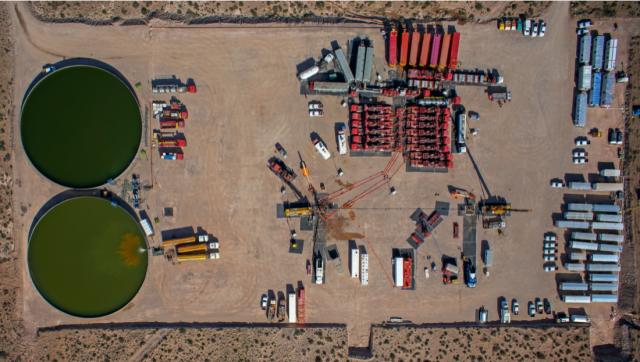
(Source: Sobrevolando Patagonia/Shutterstock.com)
It has been talked about for years, and analogies go back decades.
However, fracture-driven interactions (FDIs) are still puzzling U.S. shale players looking to better understand how hydraulic fracturing along with well spacing, fluid, proppant, pressure and rock interact to impact production.
Aiming to maximize rates of return from low-cost wells amid continued investor pressure, operators are focused on finding optimal spacing and techniques. Advanced technologies such as fluid tracing and fracture diagnostics have targeted the issue to mitigate risks. But there appears to be no simple, or universal, formula to cracking the code, given inconsistencies in reservoir rock, details on fracture location and length, and other unknowns.
Uneven distribution of fluid volume among clusters has resulted, in some instances, in only some perforation clusters contributing to production. Child-parent well interactions have also been a challenge, which has led to spacing changes in some shale plays.
“Extreme limited entry (XLE) is part of the solution, but by itself, it’s not going to completely address the challenge,” Neal Nagel, chief engineer and principal at Richmond, Texas-based OilField Geomechanics, said Sept. 22 during a webinar.
FDIs is the topic of a two-part webinar that continues next week.
“Controlling fracture propagation is the pressure drop from the wellbore proper all the way to the tip. What controls that pressure drop? Well, a significant portion is the perforation, but it’s not the only part,” Nagel said. “Stress shadows is impacting that pressure drop past the perforation out to the tip. So, when we think about what is it that’s controlling the ability of one cluster over another to propagate, to take fluid and propagate, yes, the perforations are part of the story, but the rock fabric is another part of the story.”
Speaking on what he called “rogue-length hydraulic fractures,” or fractures are that longer than predicted, Nagel highlighted the following factors to consider when studying the mechanics of fracks.
Cluster Efficiency: Instead of seeing whether each cluster took fluid, a question to answer is whether each cluster took its representative share of fluid. Nagel pointed out that industry results suggest 40% or more of clusters are often not stimulated.
Getting 100% cluster efficiency doesn’t necessarily mean getting equal distribution of fluid into each cluster. “Some clusters are taking a bigger share of fluid and proppant with the corresponding additional fracture propagation,” Nagel explained. Most operators design for an equal share within each cluster.
Stress Fields & Heterogeneity: This can play a big role in FDIs associated with parent-child well relationships. The parent well’s depletion field creates a lower stress environment that enables the fracture from the child well to enter that lower stress environment. “It [the child] stops growing away from the parent and it accelerates toward the parent because it’s the path of least resistance,” which is the route fractures always follow, Nagel said. Consider whether the stress field is in virgin conditions or in a disturbed produced condition.
Stress Shadows: A closer look at stress shadows, which relates to the increase of stress near a fracture, is also warranted in Nagel’s opinion. A question to ask includes “What does the dynamic changing stress field do to fracture propagation?” As explained in his presentation, “stress factors will alter the stress field, creating a heterogeneity in the stress field which may influence fracture propagation and promote ‘rogue-length hydraulic fractures.’”
Rock Fabric: Heterogeneity within the rock also must be accounted for, considering it impacts how the rock is fractured and its flow path, Nagel said. “It can either be something that impedes fracture propagation. The fracture cannot cross that fabric, or it becomes a superhighway and diverts the fracture,” he said. “So, rock fabric is potentially a negative or a positive; we don't know until we’ve done that characterization.”
Nagel plans to take a deeper dive into these factors and FDIs during the second of a two-part webinar on the topic next week.
Recommended Reading
Thanks to New Technologies Group, CNX Records 16th Consecutive Quarter of FCF
2024-01-26 - Despite exiting Adams Fork Project, CNX Resources expects 2024 to yield even greater cash flow.
Cheniere Energy Declares Quarterly Cash Dividend, Distribution
2024-01-26 - Cheniere’s quarterly cash dividend is payable on Feb. 23 to shareholders of record by Feb. 6.
Marathon Petroleum Sets 2024 Capex at $1.25 Billion
2024-01-30 - Marathon Petroleum Corp. eyes standalone capex at $1.25 billion in 2024, down 10% compared to $1.4 billion in 2023 as it focuses on cost reduction and margin enhancement projects.
Humble Midstream II, Quantum Capital Form Partnership for Infrastructure Projects
2024-01-30 - Humble Midstream II Partners and Quantum Capital Group’s partnership will promote a focus on energy transition infrastructure.
Hess Corp. Boosts Bakken Output, Drilling Ahead of Chevron Merger
2024-01-31 - Hess Corp. increased its drilling activity and output from the Bakken play of North Dakota during the fourth quarter, the E&P reported in its latest earnings.






